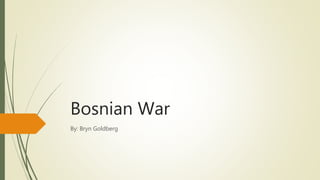Bosnian War
- 1. Bosnian War By: Bryn Goldberg
- 2. Who was Involved? ïī 43% Bosnian Muslims ïī 33% Bosnian Serbs ïī 17% Bosnian Croats ïī approximately 7% of other nationalities
- 3. Why War? ïī Power ïī Dominance over others ïī Territory ïī The divide of the former Yugoslavia
- 4. Nature of War ïī Political Dimension ïī Human Dimension ïī Existence of Uncertainty
- 5. Causalities of War ïī 100,000 deaths ïī 2.2 million people displaced ïī ~20,000 women raped
- 6. Results of the War ïī Comparisons ïī This was the âlargest massacre in Europe since the Holocaustâ ïī Nuremberg Trials versus War Tribunal for the former Yugoslavia ïī Womenâs presence in War Tribunals ïī Fear for women to testify against their rapists ïī Female survivors and attorneys
Editor's Notes
- In 1991, the Croatia and Serbia leaders met to âdivide up Bosnia and HerzegovinaâĶleaving a small enclave for Muslimsâ (ICTY 2009). This discussion perpetuated the hate of the Muslim population and ultimately led to the beginning of the war. Along with wanting to banish an entire group of people, the Serbs and Croats wanted to annex Bosnian territory for their own land respectively. In order to have this land, the groups aimed to wipe out the other Bosnians who occupied the territory by placing the men in concentration camps and raping the women.
- There is an âenduring natureâ that war demonstrates through âfour continuities: a political dimension, a human dimension, the existence of uncertainty and that it is a contest of willsâ (McMaster 2013). This civil war caused political change at an international level with the International Criminal Tribunal for the former Yugoslavia and impacted change for the treatment of humans (especially the victims). The other dimension of the war that is still lingering today are the uncertainties of the future of Bosnia for the residents of the country and the refugees who had fled during the war.
- The number of deaths are exponentially less than the number of people directly affected by the war. Thousands of people were displaced from their homes and communities, many of them then fled to other countries for survival. Even though the number of deaths is less than the number of women raped or the number of people displaced, the causalities of the war continue to add up from the families that fled for their safety and the number of women who were raped but never reported it.
- In the case of the International Criminal Tribunal for the former Yugoslavia, the 16 women who had agreed to testify against their rapists, then began having second-thoughts and fear around testifying. By raping these women, the Serbians were able to cause them immediate harm that would impact the rest of their lives, making it their most impactful war tactic. They were all fearful for their safety and lives, but realized that âthere would be no justice if witnesses didnât testifyâ, which is a powerful stand against their proprietors (Hogan 2011). In order to ensure their safety, they hid their names, faces, and voices from the defendants, again, empowering them against the rapists (Hogan 2011). The biggest difference in the War Tribunal for the former Yugoslavia versus the Nuremberg Trials was the number of women involved in the process. By having multiple female attorneys involved, womenâs voices were more prominent in the courtroom, which may have also helped the survivors testify.






